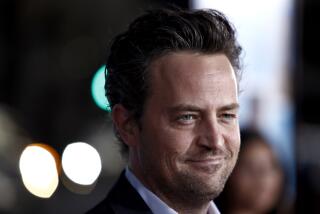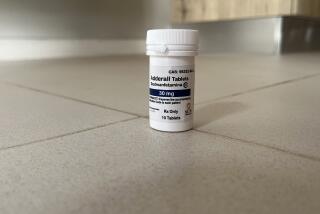Pill-abuse depiction is legit
- Share via
“Charlie Bartlett”; MGM Pictures and Sidney Kimmel Entertainment; release date Feb. 22.
The premise: Charlie Bartlett (played by Anton Yelchin) has been kicked out of several private schools before he enrolls in a public high school. He sets himself up as the resident “psychiatrist,” dispensing advice and prescription drugs from a stall in the boy’s bathroom. Charlie obtains these medicines (which include the antidepressant Zoloft, the antianxiety pill Xanax and the stimulant Ritalin) by first reading up on psychiatric diagnoses and then feigning the classic symptoms on visits to a psychiatrist, who prescribes them. Charlie treats his fellow students for conditions that include depression and panic attacks and, at one point, dispenses Ritalin at a party, causing his fellow students to become excited and uninhibited (the girls remove their blouses). But fellow student Kip Crombwell (Mark Rendall) overdoses on Charlie’s sedatives and has to have his stomach pumped (vomiting is induced and charcoal administered to absorb the drugs) in the ER. Soon afterward, Charlie reforms his behavior.
The medical questions: How common is prescription drug abuse among teens? Where do most kids get the drugs? Does Ritalin, a stimulant, remove inhibitions? Do most teens who abuse or misuse prescription drugs grow out of it or is this behavior predictive of drug dependency for adults?
The reality: The growing abuse of prescription drugs among America’s youth has been well-documented. About 2.1 million teens abused prescription drugs in 2005, according to the National Survey on Drug Use and Health. One out of five high school seniors used prescription drugs for nonmedical reasons over the last year, according to Partnership for a Drug-Free America. And the number of teens going into treatment for prescription drug abuse of pain medication has increased by more than 300% during the last 10 years, says the federal Drug and Alcohol Services Information System.
Rachel Gonzales, an addiction researcher at UCLA, says many teens obtain the pills by feigning symptoms for physicians. Others get them through the Internet, by filching from other members of their family or from their peers.
The effects of antidepressants and antianxiety medications are described accurately in the film. Charlie’s friends appear to be depressed and anxious, suffering from social anxiety, rejections and peer pressure. But without a physician’s guidance, overdoses such as Kip’s can happen easily.
Ritalin does make people hyper-alert, as the film suggests, but it does not generally remove inhibitions. If a group of teens took the drug at the same time, their actions would probably become accelerated and even grandiose, but they probably would not remove their clothes. Gonzales says that “pharm parties, where several different kinds of drugs are mixed together,” are increasingly common, as the film shows.
As for the outlook for kids who abuse such drugs, the National Survey on Drug Use and Health has found that those who use prescription drugs nonmedically before age 16 are far more likely to develop a substance abuse dependence disorder later in life.
“Treatment for adolescent prescription drug abuse has not been proven to be effective,” says Rick Rawson, professor of psychiatry and co-director of the Integrated Substance Abuse Programs at UCLA. “The film plays fast and loose, but this is a serious public health problem.”
--
Dr. Marc Siegel is an internist and an associate professor of medicine at New York University’s School of Medicine. He is also the author of “False Alarm: The Truth About the Epidemic of Fear.” In The Unreal World, he explains the medical facts behind the media fiction. He can be reached at marc@doctorsiegel.com.
More to Read
Sign up for Essential California
The most important California stories and recommendations in your inbox every morning.
You may occasionally receive promotional content from the Los Angeles Times.













